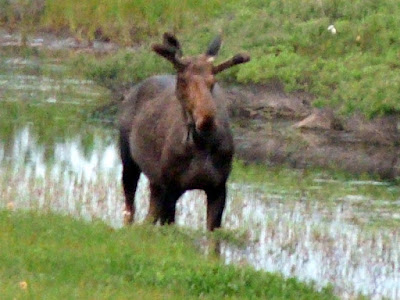Gros Morne National Park is a spectacular and unique combination of mountains, forests, barrens, seascape and diverse geology.
The Discovery Center is very complete with many exhibits, audio-visual presentations and ranger-led hikes.
A place where people have lived for 4,500 years, this rare landscape tells the story of the earth’s transformation.
The rocks and geologic features exposed within this place are the result of continents colliding and separating, oceans rising and falling, and glaciers advancing and receding. Tectonic forces heaved the park’s rocks into place and raised mountains here that were later carved out by glaciers, frost, and flowing water.
This is a land of sharp ridges, huge cliffs, coastal bogs and highland tundra, and dramatic ocean inlets and lakes.
Orange-brown rock which forms the Tableland Mesa, when exposed to the elements over time, changes to serpentine appearance.
This is a geologists paradise, once an ocean floor, later thrust up to become part of the Appalachian Mountains.
This orange-brown rock, called peridotite, is one of the best and most accessible examples of exposed earth mantle material in the world.

Many types of scientists are working in the park, some characteristics of which are found no-where else on earth.
NASA and Canadian space agency geologists are studying very high alkaline water coming from underground springs that is thought to be similar to that found on Mars.
Serpentine lines are easily seen in this rock.
The soil here is rich in iron, chromium and nickel and low in essential soil nutrients for plant growth, supporting many types of carnivorous plants--
--like the Pitcher Plant above.
If you look close you will see a tasty bug as a meal.
Yellow Lady Slipper
Sedge meadows, boreal forests, fens, bogs, moss cliffs, lichens, tundra and Heath Barrens are all common names here.
Soil in the meadows is waterlogged peat, punctuated with pools called flashets.
The theory of Plate Tectonics, that suggests continent sized plates of the Earth’s crust have repeatedly collided and separated over time opening and closing oceans between them, was primarily developed here.
To learn more about this area: www.pc.gc.ca/grosmorne
We saw the first moose on the trip today, right outside our window.
Camp tonight is in the town of Woody Point on the Bonnie Bay fjord, explored in 1766 by our good friend Capt. Cook. High in the distant background is the Tablelands, once a slice of an ancient ocean floor, like no place else on earth.




















































